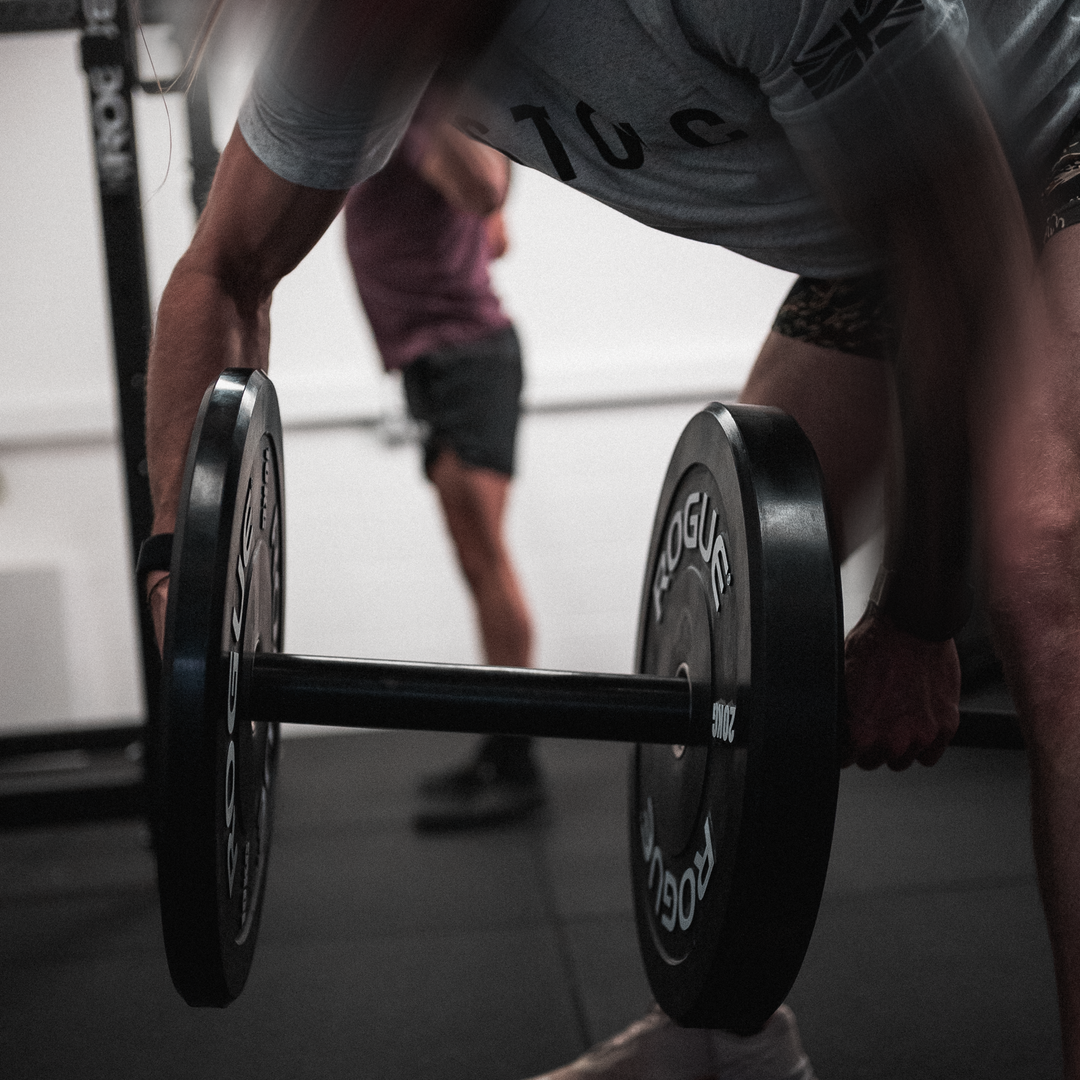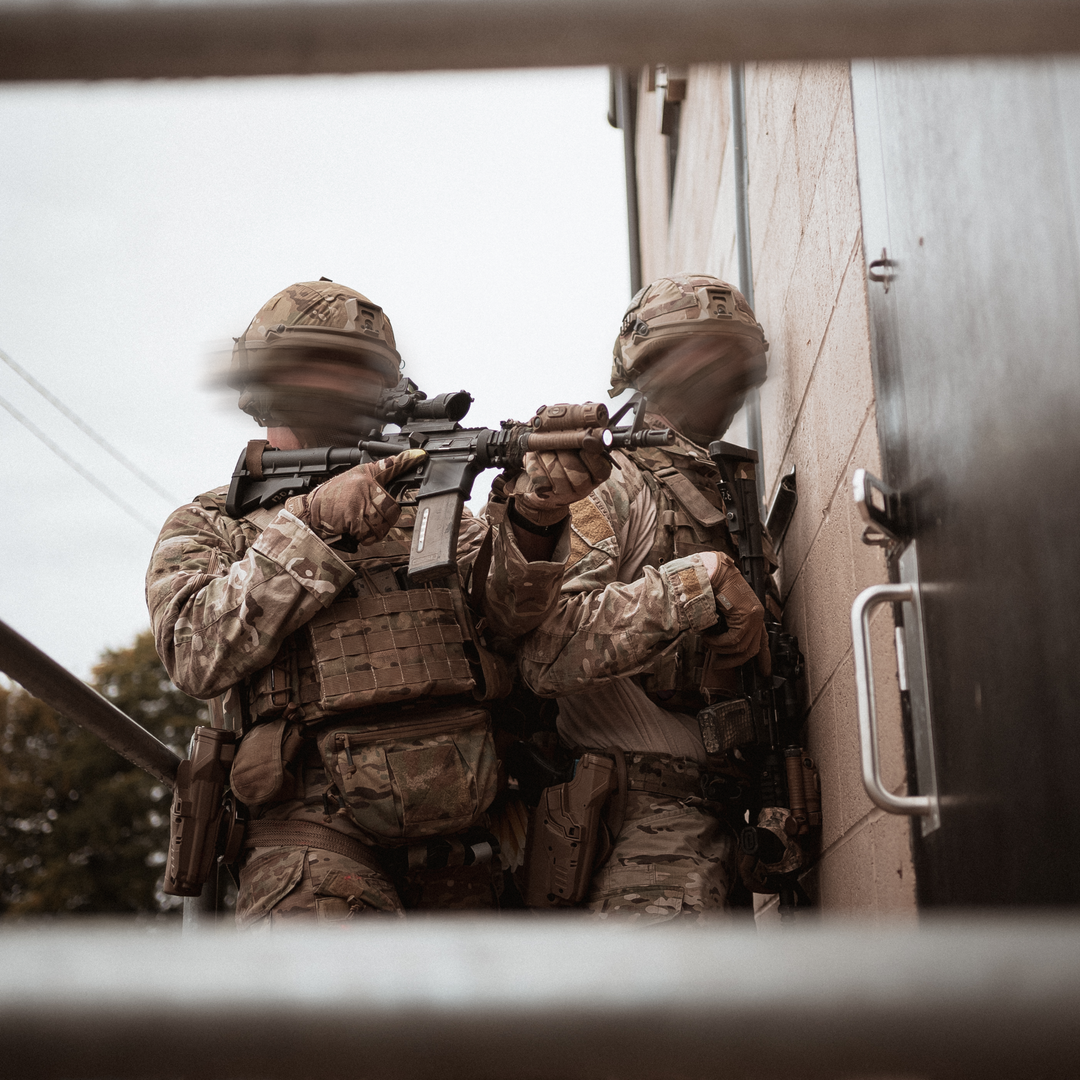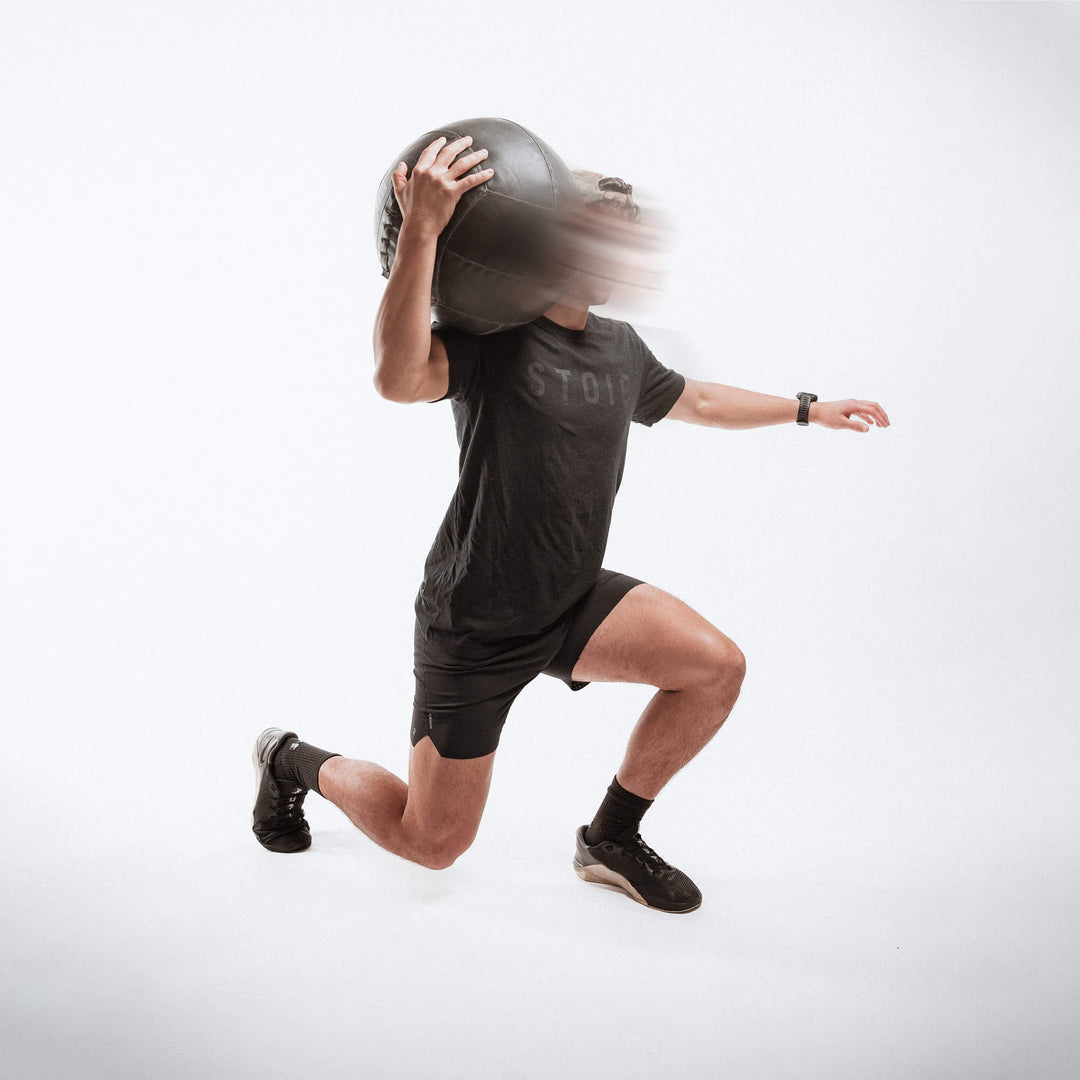KNEE INJURIES: THE 5 W'S

Knee injuries are a common problem for military personnel and active individuals, and can cause significant pain, discomfort, and loss of function through the joint that can at the least greatly hinder training progression, or at worst can end a career.
In this article, we’ll go through the 5 ‘W’s of knee injuries, their general causes, how best to rehab them and how to ‘prevent’ and prepare your body to avoid them.
- Who: Knee injuries can happen to anyone, regardless of age, gender, or fitness level. Athletes and individuals who engage in high-impact activities are at a higher risk of knee injuries.
- What: ‘Knee injuries’ refer to any damage or trauma to the knee joint or surrounding structures, such as ligaments, tendons, and cartilage. Knee injuries can range from minor strains and sprains to more serious conditions, such as tears and fractures.
- Where: Knee injuries occur in the knee joint and surrounding soft tissue and musculature.
- When: Knee injuries can seemingly happen at any time, but they often occur during physical activity, such as sports or exercise. They can also occur due to accidents, falls, or sudden twists or impacts.
- Why: They can happen due to a variety of reasons, including overuse, poor form or technique during physical activity, lack of proper warm-up and stretching, muscle imbalances, impacts and sometimes even structural abnormalities.
The general causes of knee injuries
Knee injuries pose a significant concern for military personnel, as they can impede their ability to perform their duties. They’re also one of the most common injuries in military personnel, accounting for around 50% of musculoskeletal injuries, according to studies published in Military Medicine.
Traumatic injuries
These can occur unexpectedly in military training or combat. For example, a soldier may hurt their knee while disembarking from a helicopter, landing awkwardly after a parachute jump, or slip and fall while sprinting. Similarly, they may twist their knee while engaged in combat or sprinting over rough terrain to make a cut-off time at a waypoint.
Overuse injuries
Also relatively common, overuse injuries can include patellar tendinitis, iliotibial band syndrome, and chondromalacia patella and can occur as a result of repetitive activities like marching, sprinting, and carrying heavy equipment. Another study published in Military Medicine discovered that similar injuries are common among military recruits, with up to 25% experiencing knee pain during basic training.
Biomechanical injuries
Biomechanical issues such as malalignment, large muscular imbalances, or structural abnormalities in the knee joint can lead to some dysfunction and pain. For example, soldiers who carry high loads on one side of the body, or who wear gear that isn’t fitted properly, might develop muscular imbalances that exert excessive stress on specific portions of the knee joint. Individuals with structural abnormalities, such as patellar malalignment, may also be more prone to knee pain.
Specific types of knee injury and their symptoms
There are several different types of knee injuries, each with its own set of symptoms and treatment options. The most common knee injuries military personnel experience include:
| Condition | Description | Symptoms |
| Knee sprain | Occurs when the ligaments supporting the knee joint are stretched or torn | Pain, swelling, difficulty moving the knee |
| Knee strain | Occurs when the muscles or tendons supporting the knee joint are stretched or torn | Pain, stiffness, weakness in the knee |
| Meniscus tear | Tear in the small, crescent-shaped piece of cartilage (meniscus) in the knee joint that helps absorb shock and distribute weight | Pain, swelling, difficulty bending or straightening the knee |
| Patellofemoral syndrome | Common overuse injury caused by patella (kneecap) not moving smoothly over femur (thigh bone) | Pain in the front of the knee, especially when climbing stairs or squatting |
| IT (iliotibial) band syndrome | Inflammation and irritation of the IT band, a thick band of tissue from hip to shin | Pain on the outer part of the knee, caused by overuse, lack of proper warm-up, or inadequate mobility routines |
| Ligament tears | Tear in the strong bands of tissue connecting femur to tibia and stabilising the knee joint | Pain, swelling, instability in the knee, caused by sudden change in direction or landing awkwardly from a jump |
| Knee bursitis | Inflammation of the small fluid-filled sacs (bursae) near the knee joint | Pain, swelling, stiffness in the knee, caused by overuse, direct trauma, or potentially infection; types include prepatellar bursitis, infrapatellar bursitis, and pes anserine bursitis |
What to do if you have a knee injury
If you do sustain a knee injury, seeking professional advice initially will help you determine the best course of action. We cannot emphasise enough the need to start this process as soon as possible rather than prolonging it and allowing things to spiral out of control. The sooner you can begin rehabilitation training (which is simply regular training scaled to your current capacity), the better your outcomes will be.
After you have consulted with a professional as to what your specific guidelines should be, the primary aims of your rehabilitation following that should be:
Phase 1: To reduce pain and swelling
- Rest if needed, but ideally, keep moving if tolerable.
- Elevation and compression garments may help reduce swelling if not contraindicated.
- Soft tissue treatment such as light massage will aid in reducing swelling.
Phase 2: Restore and improve range of motion
- Work to your tolerance. Nudge the boundary of pain but don’t push far into it.
- Focus on restoring your knee extension and slight hyperextension range of motion first.
- Follow this with restoring knee flexion. This can take time depending on the severity of the injury.
Phase 3: Restore and improve the strength and function of the joint beyond its previous capacity
- Start to introduce movements using your body weight such as box squats, split squats, and Poliquin step downs.
- Incrementally load them to your tolerance, making sure to focus on moving through a full range of motion.
- If you have tendinopathy-based injury, the use of eccentric loading is recommended in this phase.
Phase 4: Increase confidence with dynamic and multidirectional movements
- Start to introduce plyometrics, jumps, lateral jumps, depth jumps, change of direction drills and reaction-based challenges.
It’s important to keep in mind that not only is every injury mechanism potentially unique but each individual, their past, training history, tolerance, beliefs, and biology are all unique. As such all of these phases exist on a continuum, meaning that you can jump back and forth if needed and you shouldn’t always expect to progress linearly through any injury rehabilitation.
What about R.I.C.E?
The RICE acronym (Rest, Ice, Compression, Elevation) has been largely disproven as an effective approach to rehabilitation for most injuries in recent years. While it was once widely used as a routine therapy plan, research has revealed that excessive rest and immobilisation can actually delay recovery and lead to muscular weakness and flexibility loss.
Furthermore, while icing may momentarily relieve pain, it also restricts blood flow and postpones healing. Although compression and elevation can help reduce swelling, their effectiveness in encouraging recovery is limited. As a result, healthcare providers should now advocate for more active and tailored rehabilitation measures, such as targeted exercise and movement, as well as adequate rest and recovery when necessary.
However, assuming using ice is not contraindicated, it doesn’t really matter in the grand scheme of things. It won’t speed up tissue healing, but you can choose to use ice based on your preference.
Best general practices for avoiding knee injuries
“An ounce of prevention is worth a pound of cure.”
Benjamin Franklin
In our first warm-up article, we presented the following simple injury equation:
(Injury = Demand > Capacity)
This emphasises that, while it is impossible to completely prevent an injury from occurring, we can increase the capacity of your muscles and joints so they can keep up with the demand you place on them.
There are several strategies that can help reduce the risk of knee injuries. These include:
Warming up correctly
- A proper warm-up can increase blood flow to the muscles and improve flexibility, reducing the risk of knee injuries.
- A dynamic warm-up, mimicking the activity to be performed, can improve muscle activation and reduce knee injury risk (Hickey et al., 2018).
- A 10-minute warm-up of jogging and dynamic stretching and mobility improved knee joint range of motion and muscle activation (McKay et al., 2018).
- Having a warm-up specific to the individual and the training session can help prevent knee injuries, such as our GSR template.
Strength, endurance and dynamic exercises
- Resistance training for your lower body can improve knee, ankle and hip joint strength and stability which can help reduce the risk of injury as well as help speed up recovery
- A multifaceted strength training program including strength, plyometric and balance exercises is the best way to reduce knee injury risk in athletes (Pfile et al., 2012).
- Squats, lunges and jumps were effective in reducing knee injury risk in athletes (Kvist et al., 2004).
Having proper footwear
- Proper footwear can support feet and ankles, reducing the risk of knee injuries. Especially good to consider when training or operating on uneven terrain.
- Whilst not essential, wearing shoes with a stable sole and good arch support can potentially reduce the risk of knee injuries in runners (Mundermann et al., 2005).
- There’s more evidence that improving the strength in your lower leg and feet and managing your training volume correctly is more important than any specific shoe or insole.
- When choosing footwear, the biggest factor to consider is correct fit and comfort over anything else.
Working on large muscular imbalances
- Correcting biomechanical issues, such as large muscular imbalances and poor alignment, can potentially help to reduce the risk of knee injuries.
- Hip and trunk strengthening programs help to improve hip and knee mechanics, potentially reducing knee injury risk (Lee et al., 2021 and Aboodarda et al., 2020)
- Military personnel may develop muscular imbalances due to the physical demands of their job, such as carrying heavy loads or wearing protective gear. Repeated physical training, particularly if it is focused on certain muscle groups while neglecting others can also create imbalances.
Avoiding overuse
- Possibly the biggest factor in reducing the risk of any injury – knee injuries can be the result of simply doing too much too soon and mismanaging your training volume.
- Avoiding overuse of the knee joint, such as excessive running, jumping or running with load, can reduce the risk of knee injuries, especially in basic training (Knapik et al., 2018 and Beutler et al., 2017).
- This is one of the reasons that a well-structured, concurrent training programme is crucial for the long-term development of strength and conditioning.
Building strength and mobility to avoid knee injuries
You should approach this with simply the mentality of continual incremental progression to improve your capacity so that they can withstand the high demands placed on them.
Improving your capacity can entail:
- Increasing absolute strength using resistance training.
- Improving the endurance of your legs
- Working on the mobility of your knee joint (flexion, extension, tibial rotation, patella movement)
- Making sure the strength you have in your end ranges is high using isometrics and full range of motion training
- Not neglecting jumping, landing, hopping, bounding and lateral movements
Conclusion
Knee injuries can be painful and debilitating, but with the right prevention and rehabilitation strategies, they can be effectively mitigated and managed.
It is important to seek out a consultation with a healthcare professional if you are experiencing knee pain or have suffered a knee injury early on to ensure the best possible treatment and outcome. After this you can apply the different phases of rehabilitation we have laid out here to help speed up your recovery.
Appendices
Recent studies on effective rehabilitation methods for knee injuries show us that:
- Strength training and neuromuscular re-education reduce knee pain and improve function in patellofemoral pain syndrome patients (Lack et al., 2018).
- More specific rehabilitation programs are more effective in reducing pain and improving function in knee osteoarthritis patients (Van Ginckel et al., 2020).
- Eccentric exercise reduces pain and improves function in patellar tendinopathy patients (Beyer et al., 2015).
- Combining strength and proprioceptive training reduces knee pain and improves function in ACL injury patients (Liu et al., 2020).
- Progressively adding load during a rehabilitation program is more effective in improving knee function and reducing pain in meniscus injury patients than standard programs (Culvenor et al., 2018).
All of these studies suggest that a combination of strength training, neuromuscular re-education, proprioceptive training, and specific training programmes will be most beneficial in healing knee injuries and improving function.
References
Lack S, Barton C, Sohan O, Crossley K, Morrissey D. Proximal muscle rehabilitation is effective for patellofemoral pain: a systematic review with meta-analysis. Journal of Orthopaedic Sports Physical Therapy
Van Ginckel A, Thijs Y, De Clercq D, et al. A personalized rehabilitation approach improves pain and function in patients with knee osteoarthritis. Journal of Orthopaedic Sports Physical Therapy
Beyer R, Kongsgaard M, Hougs Kjær B, Øhlenschlæger T, Kjær M, Magnusson SP. Heavy slow resistance versus eccentric training as treatment for Achilles tendinopathy: a randomized controlled trial. American Journal of Sports Medicine.
Liu Y, Qi W, Liu Y, et al. Proprioceptive training for the prevention of ankle sprains: an evidence-based review. Journal of Sport Health Science.
Culvenor AG, Collins NJ, Guermazi A, et al. Early knee osteoarthritis is evident one year following anterior cruciate ligament reconstruction: a magnetic resonance imaging evaluation. Arthritis Rheumatology.
Military Medicine. (2018). Musculoskeletal injuries and workload of soldiers in complex environments: A survey study.




